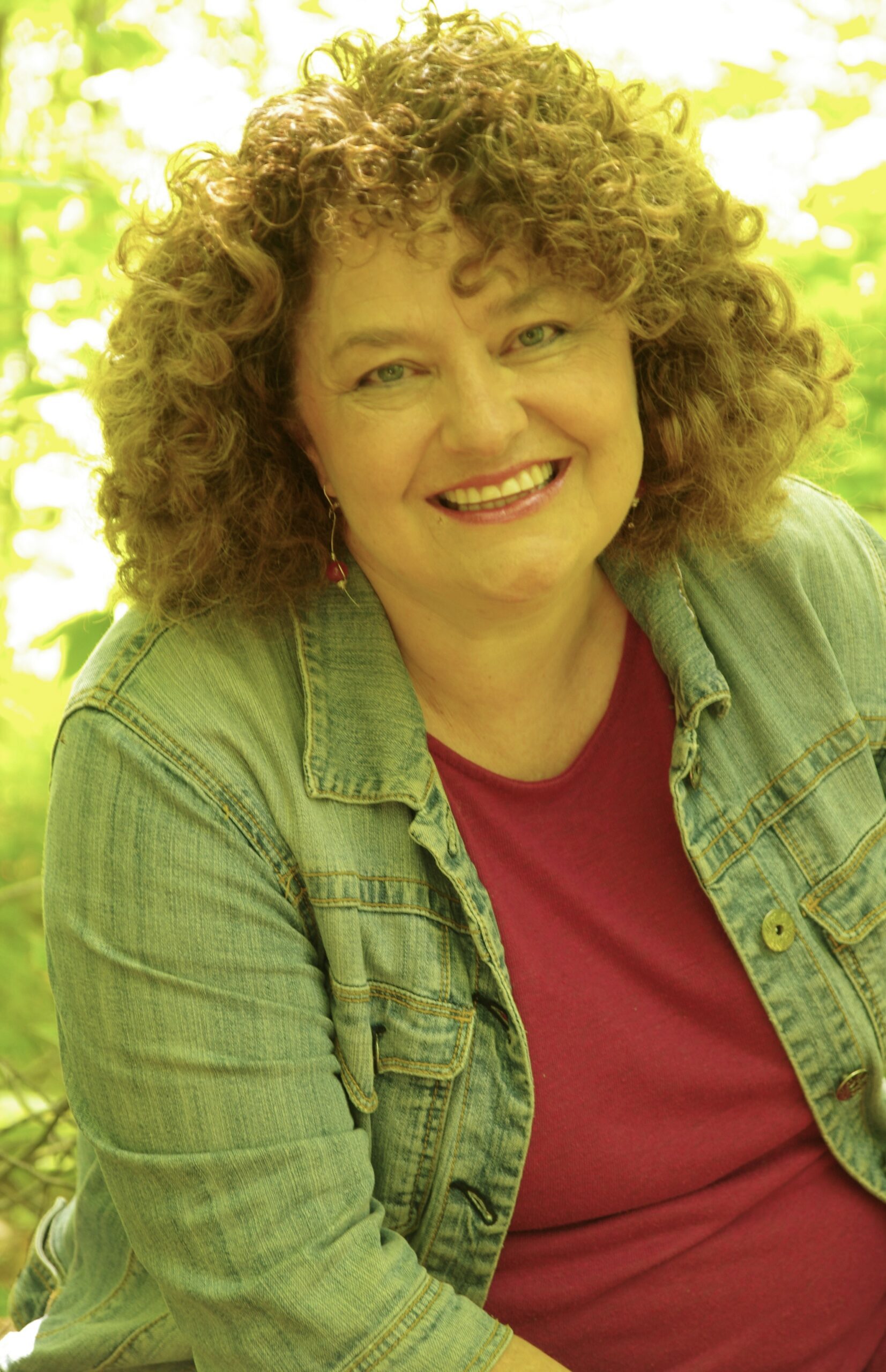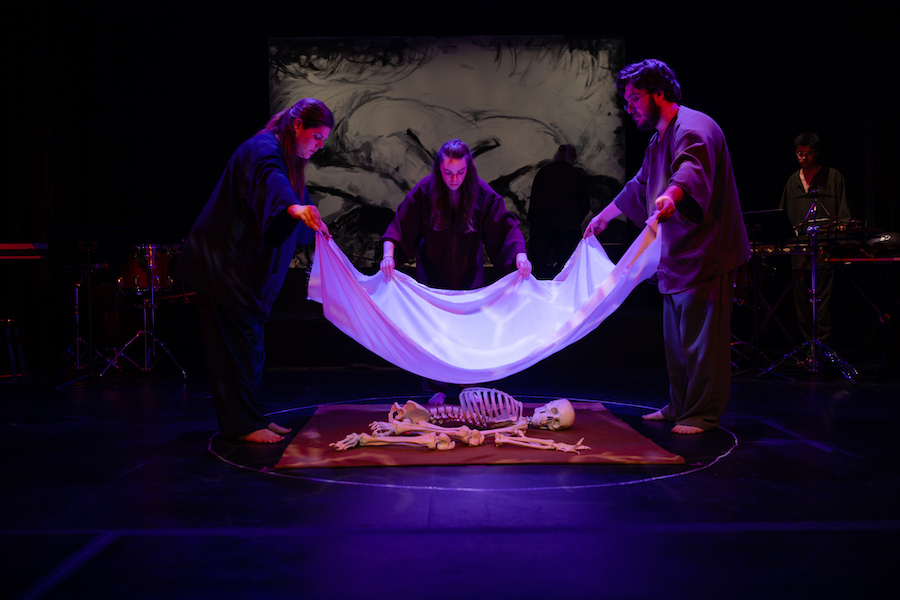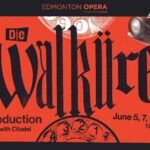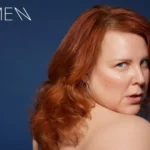On August 17 and 19, at the Northern Lights Performing Arts Pavilion in Haliburton, Ontario, patrons of Highlands Opera Studio witnessed a remarkable artistic creation. Regeneration, a multi-textured work designed and directed by Valerie Kuinka, was inspired by the legend of the bone-gathering women, La Loba (Wolf Woman). In the legend, when La Loba has collected a complete skeleton, she meticulously arranges the pieces on the ground in front of her and sings to them. As she sings, the bones transform into a living being which runs freely back into the desert.
The evening began with the electro-acoustic recording, Cricket Voice, a sonic environment created by Hildegard Westerkamp, a Vancouver-based composer who records natural sounds and manipulates them electronically. While this played, visual artist Grethe Jensen painted a large black and white mural. The evening progressed through three stages, demonstrated in Jensen’s painting: fractured pieces, a figure emerging from these pieces, and a completed figure in a fetal position surrounded by splashes of red paint representing the possibility of rebirth. As the painting evolved, so did the music surrounding it. Soloists Gabrielle Côté-Picard (soprano), Rebecca Gray (soprano and composer), and James Coole-Stevenson (baritone) carefully placed parts of a human skeleton centre stage as they indivdually emerged from the audience to share musical offerings. Since one of Kuinka’s goals was to demonstrate that opera is not the realm of one culture, a kaleidoscope of music was used—from “traditional” opera to Japanese inspired pieces to German art songs to Canadian music based upon Indigenous chant style. Coole-Stevenson’s singing of “Vier ernste Gesange – no, 1”, by Johannes Brahms, contained the rich, dark tonality suited to the mournful laying of bones in earth. Mozart’s “Porgi Amor” was sung with such emotion by Côté-Picard, that the staging of this aria about abandonment by the broken bones of a woman was truly gut wrenching. Gray’s interpretation of “Apparition — Vocalize 2: Invocation” contained vocal acrobatics that left the audience in awe of her ethereal tone. Particularly intriguing was an improvisation created and directed by Ian Cusson, Gray, and Kuinka. A playful interaction of tonality in what was generally a sombre production, this section featured improvisations by the soloists which included speaking, playing instruments, dancing, and audience participation. In the latter part of the show, 15 Highlands Opera Studio participants provided the lush harmonies of Andrew Balfour’s “Vision Chant”. Dressed in earth-coloured hooded robes, the chorus danced and sang their way into a frenzied celebration of rebirth. Samira Tou’s backlit shadow dance turned into a powerfully choreographed celebration of life once the veil was lifted from the skeletal remains.
And then there was Michael Murphy’s sound design. Throughout the evening, watching percussionist Murphy was a sensory smorgasbord. His command of his instruments was astonishing—from traditional drums and other generally recognized rhythm instruments, to the Japanese shō, to the use of bows on a vibraphone, to something as simple as using knitting needles to play clay pots. There were congas and bongos originating from Latin America, cymbals which originated from Turkey, crotales originating from ancient Greece and Rome, and tambourines from the folk traditions in Europe. Couple these instruments with Frances Thielmann’s creative piano playing (particularly her plucking of the piano strings) and her nuanced and precise conducting, and the result was a rich multicultural medley of music.
Kudos to Melissa Stephens for her strikingly simple earth toned costumes which played up the organic feeling of the entire work, as well as Adam Jules’s lighting design which enhanced the overall feeling of a world being replenished. Jules had the tricky job of lighting for dance, chorus, musical instruments, as well as a painted mural at the back of the stage, yet he did it all with elegantly simple transitions.
Kuinka described Regeneration as a “theatrical collage”. But it was much more than that; it was a stunning example of what collaboration between artists of different ethnicities, ages, and styles can produce while also telling a timeless tale. In order for opera to remain relevant, more works like this need to be produced. In order for opera to survive, more creative risk-taking needs to happen. New life needs to be breathed into dry bones.
Related Content ⬇
Opera Canada depends on the generous contributions of its supporters to bring readers outstanding, in-depth coverage of opera in Canada and beyond. Please consider subscribing or donating today.

Dawn Martens received a 2010 Ruby Award for opera education, as well as a 2020 Governor General’s History Award for Excellence in Teaching for an online children’s production of Brundibar. A writer for Opera Canada for over 20 years, she is currently the host of Opera Night in Canada on 100.9 Canoe FM.










